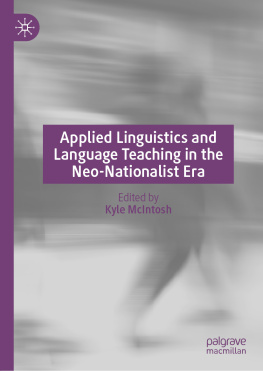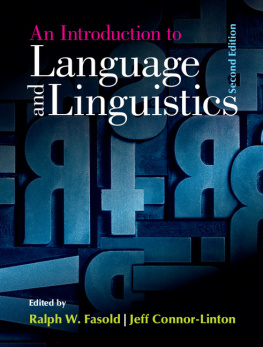Susana V. Rivera-Mills/Daniel J.Villa (eds.)
Spanish of the U.S. Southwest A Language in Transition

LINGSTICA IBEROAMERICANA
Vol. 38
DIRECTORES:
MARIO BARRA JOVER, Universit Paris VIII
IGNACIO BOSQUE MUOZ, Universidad Complutense de Madrid
ANTONIO BRIZ GMEZ, Universitat de Valncia
GUIOMAR CIAPUSCIO, Universidad de Buenos Aires
CONCEPCIN COMPANY COMPANY, Universidad Nacional Autnoma de Mxico
STEVEN DWORKIN, University of Michigan
ROLF EBERENZ, Universit de Lausanne
MARA TERESA FUENTES MORN, Universidad de Salamanca
DANIEL JACOB, Universitt Freiburg
JOHANNES KABATEK, Eberhard-Karls-Universitt Tbingen
EMMA MARTINELL GIFRE, Universitat de Barcelona
JOS G. MORENO DE ALBA, Universidad Nacional Autnoma de Mxico
RALPH PENNY, University of London
REINHOLD WERNER, Universitt Augsburg
Susana V. Rivera-Mills/Daniel J. Villa (eds.)
Spanish of the U.S. Southwest A Language in Transition
Iberoamericana Vervuert 2010
Library of Congress Cataloging-in-Publication Data
Spanish of the U.S. Southwest : a language in transition / Susana V Rivera-Milis, Daniel J. Villa (eds.).
p. cm. - (Lingistica Iberoamericana; vol. 38)
Includes bibliographical references.
ISBN 978-1-936353-01-9 - ISBN 978-8484894773 - ISBN 978-3-86527-509-7 1. Sociolinguistics-United States. 2. Hispanic Americans-Languages. 3. Language in contact. I. Rivera-Mills, Susana Victoria. II. Villa, Daniel J.
P40.45.U5S63 2010
467'.979-dc20
2010018761
Reservados todos los derechos
Iberoamericana, 2010
Amor de Dios, 1 - E-28014 Madrid
Vervuert, 2010
Elisabethenstr. 3-9 - D-60594 Frankfurt am Main
Iberoamericana Vervuert Publishing Corp., 2010
c/o Silvermine International Books - PO Box 2247 - Norwalk, CT 06852, USA
ISBN 978-84-8489-477-3 (Iberoamericana)
ISBN 978-3-86527-509-7 (vervuert)
ISBN 978-1-936353-01-9 (Iberoamericana Vervuert Publishing Corp.)
www.ibero-americana.net
Depsito Legal:
Diseo de la cubierta: Carlos Zamora
Impreso en Espaa
Este libro est impreso ntegramente en papel ecolgico sin cloro
A los de la generacin de contacto, a los Rivera, Samaniego, y Villa, a los que nos apoyaron en la creacin de este libro, en especial, Fabin Samaniego. Vivieron, viven, vivirn.
INTRODUCTION SPANISH OF THE U.S. SOUTHWEST: A LANGUAGE IN TRANSITION
SUSANA V. RIVERA-MILLS/DANIEL J. VILLA
Oregon State University / New Mexico State University
For over four centuries, Spanish has formed an enduring feature of the linguistic landscape in what is now the United States Southwest, predating the arrival of the first English speaking settlers in North America. The first permanent Spanish-speaking communities in the current day U.S. were established in La Nueva Mxico (today, New Mexico) beginning in 1598. Continuous northward, westward and eastward migrations beyond the ancestral heartland in New Mexico established Spanish-speaking populations throughout the regions comprising the modern states of California, Arizona, Colorado and Texas. These migrations moved along routes such as Los Caminos Reales de Tierra Adentro, de Baja California and de los Tejas, as well as those such as the Santa Fe Trail. Historic events such as the signing of the Treaty of Guadalupe Hidalgo, the Gadsden Purchase, the building of the railways in the 19th century, the Mexican Revolution, World War II, the Bracero Program, and the ongoing demand for labor in this country have contributed to the growth and continued dispersion of Spanish-speaking communities in this greater region.
The results of that expansion are found in U.S. Census Bureau data (www.census.gov), which indicate that in 2008 over 25.4 million Hispanics resided in the Southwest. The growth of Spanish-speaking origin population is such that other states have become part of the Southwest, not so much with regard to geography, but rather due to significant demographic changes. Jenkins (2009) asserts that a tipping point for including a state, linguistically speaking, in the Spanish-speaking Southwest is that at which Spanish speakers comprise ten percent or more of the total population. At the time of writing this introduction, 24% of Nevadas population is of Spanish-speaking origin, and in Utah and Oregon respectively represents 11% and 10% of the total residents in those states. Idaho, at 9.5%, is not far from joining the Spanish-speaking Southwest. As a result, Spanish speakers are found in the vast region west of the Mississippi stretching from the Pacific Northwest to the Gulf of Mexico, from the northern to southern borders of this nation, an area consisting of more than 1.1 million square miles. As a comparison, all of Western Europe occupies some 898 thousand square miles.
There exists a unique resilience of language and culture among Spanish speakers not found in other non-English language groups in the U.S. (Mora, Villa & Dvila 2005, 2006). As a result, this cultural and linguistic tenacity has been the topic of much research in the 20th and 21st centuries. Aurelio Espinosa, working in the early decades of the former, laid a solid foundation for research on Southwest Spanish (e.g., Espinosa 1909, 1911, 1911-1913, 1914-1915). His groundbreaking work not only documented varieties of what we now call U.S. Spanish, but also established new research paradigms in the field of linguistics. Just as importantly, this pioneer established that what some may have considered a corrupt, deficient language of the poor was indeed worthy of serious scientific study (for a discussion of these issues see Bills & Vigil 2008, Chapter 2; for a review of the scholarship following Espinosas lead, see Lipski 2008: 91-97).
The myth of Spanish as a language of poverty, liable to endanger its speakers social and economic success, persisted throughout the first half of the 20th century. Many Spanish speakers who entered the public (and often private) school systems experienced physical punishment for speaking their home language at school. One of our students who attended school in the early 60s testified to this: Un da me metieron una buena paliza por estar hablando mi lengua propia. Me metieron una zurra tan grande que no poda andar, ni caminar bien (One day they gave me a good beating for speaking my own language. They gave me such a whipping that I could barely walk). However, the nascent Civil Rights movements of the early 60s gave rise to a consciousness that equality could be expected at all levels of society, and in the regions discussed here el Movimiento Chicano, the Chicano Movement, was born. One of the many ramifications from that turbulent period was a rekindled awareness that the Spanish language formed an important element of community identity. Following Espinosas lead that Southwest Spanish was worthy of academic research, Eduardo Hernndez-Chvez, Andrew D. Cohen, and Anthony F. Beltramo (1975) published El lenguaje de los Chicanos: Regional and Social Characteristics Used by Mexican Americans, a seminal work that marked a reawakening in the study of Spanish as it exists in its social contexts here.
Seven years later, Jon Amastae and Lucia Elas-Olivares published a collection titled Spanish in the United States: Sociolinguistic Aspects, another important collection of scholarly research on varieties of U.S. Spanish. While not strictly focused on Southwest Spanish, that volume represents another important stride forward in the creation of a solid body of research literature on Spanish spoken north of the U.S.-Mexican border. The appearance of works such as these served to remove any doubt that research on Southwest Spanish forms an important segment of the general body of investigative literature on Spanish throughout the world. More recently, edited collections on Southwest Spanish such as our collection published in the
Next page











